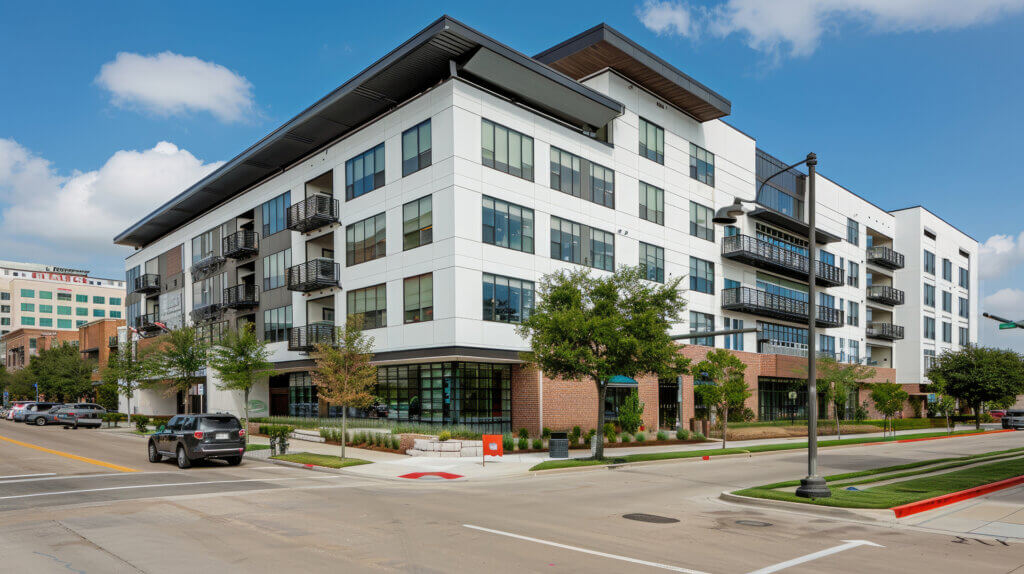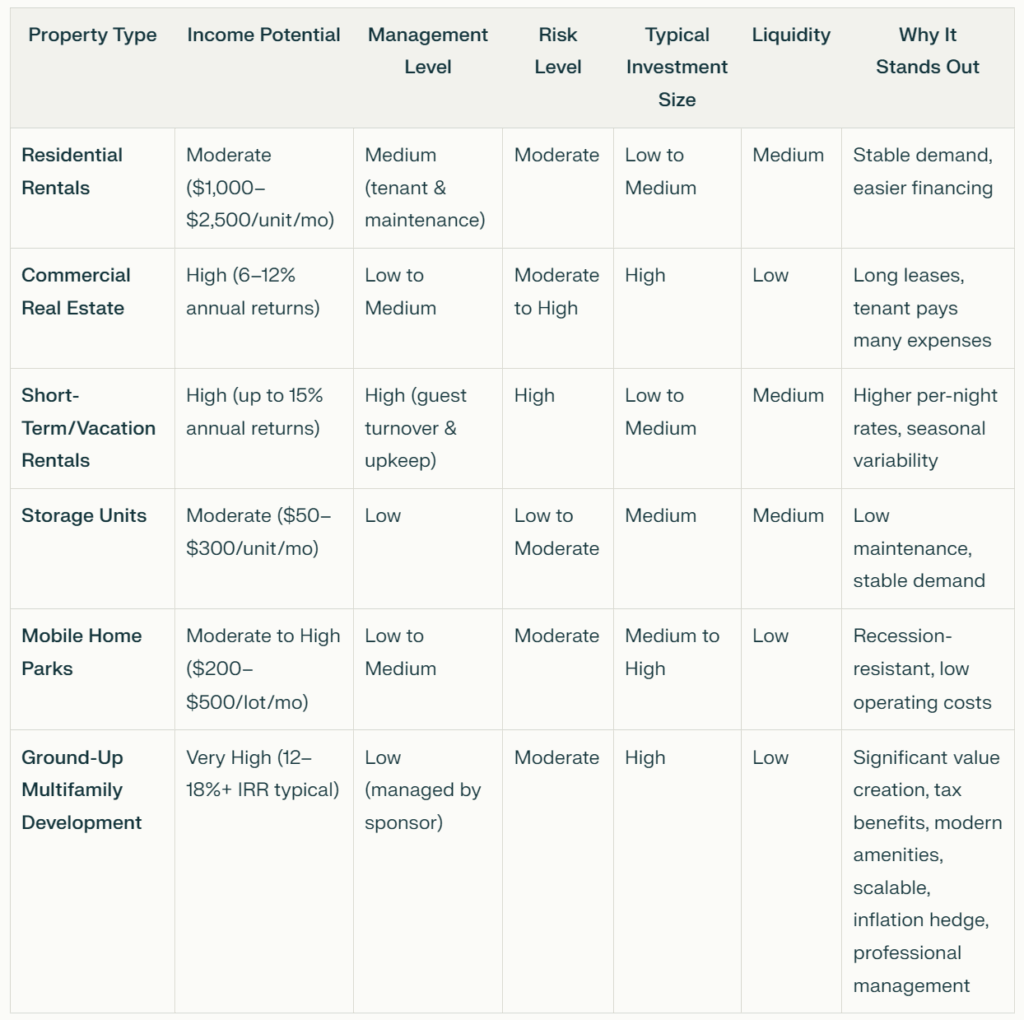Why August Is the Perfect Time to Review Your Real Estate Strategy

If you’re aiming to generate steady passive income through real estate, understanding the variety of property types available is key to finding the right fit for your investment goals and risk tolerance. Real estate offers a broad spectrum of opportunities-from residential rentals to commercial spaces, storage units, mobile home parks, and more.
Each comes with unique income potential, management demands, and market dynamics. Let’s explore five popular property types for passive income in 2025, and then dive deeper into why ground-up multifamily development is often the best choice for serious passive investors.
Residential rentals include single-family homes and small multifamily properties like duplexes or triplexes.
Why choose residential? People always need places to live, making residential rentals a stable source of monthly income. Multifamily properties, in particular, offer economies of scale and reduce vacancy risk since income comes from multiple units.
Income potential: Monthly rents typically range from $1,000 to $2,000 per unit (gross), depending on location and size.
Pros:
Cons:
Tip: Focus on growing markets like Indianapolis, where steady job and population growth support rental demand.
Commercial properties include office buildings, retail centers, warehouses, and mixed-use developments.
Why consider commercial? Commercial leases are often longer-3 to 10 years-providing predictable cash flow. Tenants usually pay maintenance and utilities, reducing landlord responsibilities.
Income potential: Typical returns range from 6% to 12% annually, with triple-net leases shifting many expenses to tenants.
Pros:
Cons:
Tip: Target properties in strong business hubs, such as Indianapolis’s growing logistics sector.
Platforms like Airbnb and VRBO have popularized short-term rentals in tourist and urban areas.
Income potential: Returns can reach up to 15% annually in high-demand markets, with dynamic pricing maximizing income during peak seasons.
Pros:
Cons:
Tip: Consider professional property managers to keep it truly passive.
Storage facilities rent out individual units to customers needing extra space for personal or business use.
Income potential: Monthly rents vary widely, typically $50 to $300 per unit, with climate-controlled units commanding higher rates.
Pros:
Cons:
Tip: Look for properties near dense residential areas or universities where storage demand is strong.
Mobile home parks consist of leased lots where residents place their manufactured homes.
Why mobile home parks? They provide affordable housing, leading to steady demand and often lower vacancy rates than other property types.
Income potential: Lot rents typically range from $200 to $500 per month, with long-term tenants reducing turnover costs.
Pros:
Cons:
Tip: Mobile home parks in growing regions like Indiana offer strong passive income opportunities with lower risk than many other asset classes.

While the property types above offer solid passive income options, ground-up multifamily development stands out as the best choice for many passive real estate investors. This strategy involves investing in new apartment communities built from scratch, partnering with experienced developers who manage everything from land acquisition and construction to lease-up and stabilization.
1. Significant Value Creation
Unlike buying existing properties, ground-up development lets you participate in the entire value creation process-from raw land to a fully leased, modern apartment complex. This often leads to higher returns as the property appreciates substantially once completed and stabilized.
2. Modern, In-Demand Amenities
New developments incorporate the latest design trends and amenities-such as energy-efficient systems, smart home technology, and community spaces-that attract quality tenants willing to pay premium rents. This leads to higher occupancy rates and stronger cash flow.
3. Lower Maintenance Costs
Brand-new buildings require less maintenance in the early years, reducing operating expenses and increasing net income for investors.
4. Tax Advantages
Ground-up projects benefit from accelerated depreciation through cost segregation studies and other tax strategies, which can significantly offset taxable income for passive investors.
5. Inflation Hedge
Rents and property values tend to rise with inflation, protecting your investment’s purchasing power over time.
6. Scalability and Diversification
Investing in multifamily developments allows you to scale your portfolio efficiently. Larger projects mean more units generating income without a proportional increase in management complexity.
7. Experienced Sponsor Management
Passive investors rely on seasoned sponsors who bring expertise in construction, finance, and property management, allowing you to enjoy the benefits of real estate ownership without the daily hassles.

Ground-up multifamily development combines strong cash flow potential, appreciation, tax benefits, and professional management, making it a compelling choice for investors seeking meaningful passive income and long-term wealth building. When paired with a trusted developer focused on transparency and disciplined execution-like Goodin Development-this strategy can be a cornerstone of your passive real estate portfolio.
By understanding these property types and why ground-up multifamily development stands out, you’re better equipped to choose the right passive real estate investments that align with your financial goals and lifestyle.
This site is protected by reCAPTCHA and the Google Privacy Policy and Terms of Service apply.
Web design by Webisserie
No Offer of Securities—Disclosure of Interests. Under no circumstances should any material on this site be used or be considered as an offer to sell or as a solicitation of any offer to buy an interest in any investment. Any such offer or solicitation will be made only by means of the confidential private offering memorandum relating to the particular investment. Access to information about the investments are limited to investors who either qualify as accredited investors within the meaning of the Securities Act of 1933, as amended, or those investors who generally are sophisticated in financial matters, such that they are capable of evaluating the merits and risks of prospective investments. Past performance is not indicative of future results. All investments have risk and we strongly recommend you seek professional guidance before making any investment.